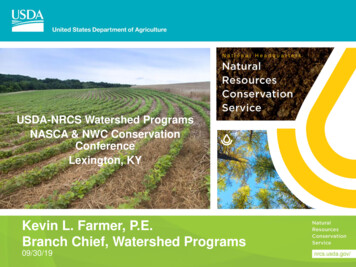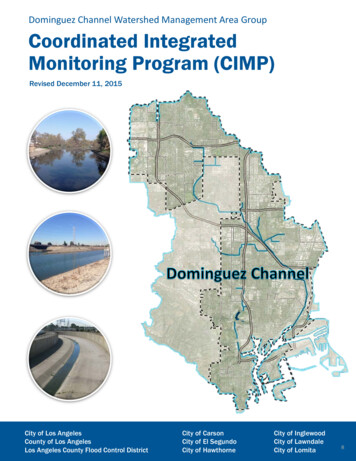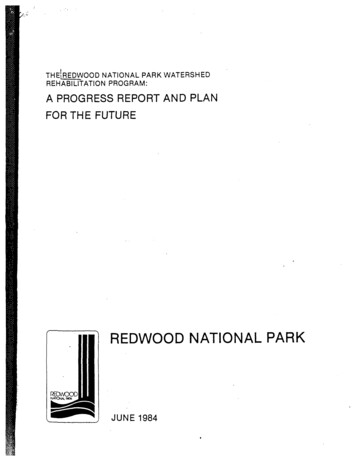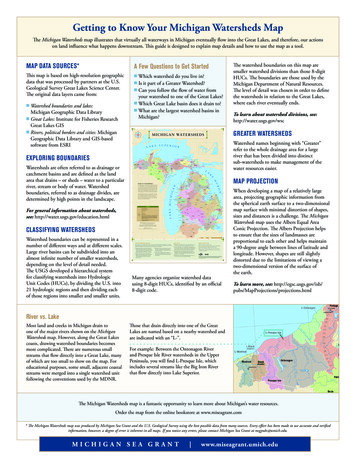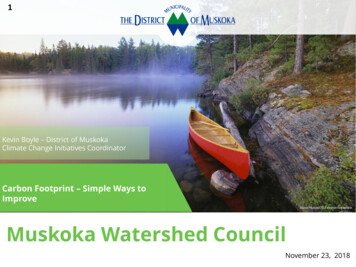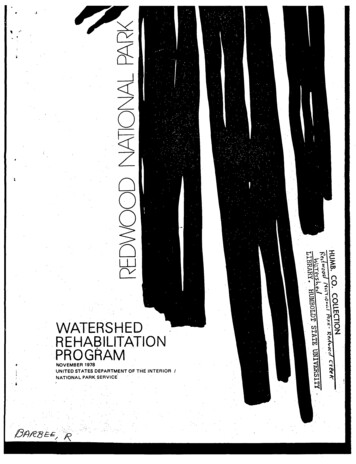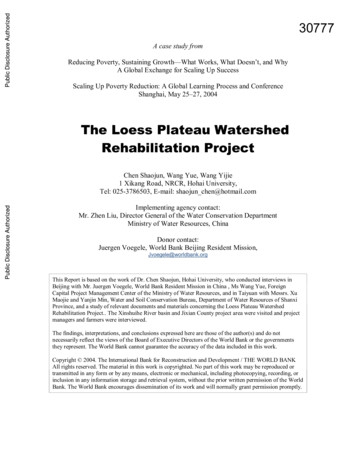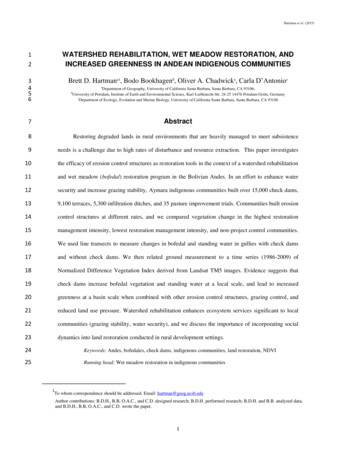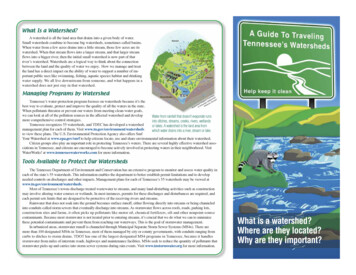
Transcription
What Is a Watershed?A watershed is all the land area that drains into a given body of water.Small watersheds combine to become big watersheds, sometimes called basins.When water from a few acres drains into a little stream, those few acres are itswatershed. When that stream flows into a larger stream, and that larger streamflows into a bigger river, then the initial small watershed is now part of thatriver’s watershed. Watersheds are a logical way to think about the connectionbetween the land and the quality of water we enjoy. How we manage and treatthe land has a direct impact on the ability of water to support a number of important public uses like swimming, fishing, aquatic species habitat and drinkingwater supply. We all live downstream from someone, and what happens in awatershed does not just stay in that watershed.Managing Programs by Watershedyesurt dCo rshe sram Wate roupgDia sas ry Gonedsh rka dvisAter of AWaTennessee’s water-protection program focuses on watersheds because it’s thebest way to evaluate, protect and improve the quality of all the waters in the state.When pollutants threaten or prevent our waters from meeting clean-water goals,we can look at all of the pollution sources in the affected watershed and developWater from rainfall that doesn’t evaporate runsmore comprehensive control strategies.into ditches, streams, creeks, rivers, wetlandsTennessee recognizes 55 watersheds, and TDEC has developed a watershedor lakes. A watershed is the land area frommanagement plan for each of them. Visit www.tn.gov/environment/watershedswhich water drains into a river, stream or lake.to view these plans. The U.S. Environmental Protection Agency also offers SurfYour Watershed at www.epa.gov/surf to help citizens locate, use and share environmental information about their watershed.Citizen groups also play an important role in protecting Tennessee’s waters. There are several highly effective watershed associations in Tennessee, and citizens are encouraged to become actively involved in protecting waters in their neighborhood. VisitWaterWorks! at www.tennesseewaterworks.com for more information.Tools Available to Protect Our WatershedsThe Tennessee Department of Environment and Conservation has an extensive program to monitor and assess water quality ineach of the state’s 55 watersheds. This information enables the department to better establish permit limitations and to developneeded controls on discharges and other impacts. Management plans for each of Tennessee’s 55 watersheds may be viewed atwww.tn.gov/environment/watersheds.Most of Tennessee’s towns discharge treated wastewater to streams, and many land-disturbing activities such as constructionmay involve altering water courses or wetlands. In most instances, permits for these discharges and disturbances are required, andeach permit sets limits that are designed to be protective of the receiving rivers and streams.Rainwater that does not soak into the ground becomes surface runoff, either flowing directly into streams or being channeledinto conduits called storm sewers that eventually discharge into streams. As stormwater flows across roofs, roads, parking lots,construction sites and farms, it often picks up pollutants like motor oil, chemical fertilizers, silt and other nonpoint-sourcecontaminants. Because most stormwater is not treated prior to entering streams, it’s crucial that we do what we can to minimizethese potential contaminants and prevent them from reaching our waterways. This is the goal of stormwater management.In urbanized areas, stormwater runoff is channeled through Municipal Separate Storm Sewer Systems (MS4s). There aremore than 100 designated MS4s in Tennessee, most of them managed by city or county governments, with conduits ranging fromcurbs to ditches to storm drains. TDOT has one of the largest designated MS4 programs in Tennessee, because it handlesstormwater from miles of interstate roads, highways and maintenance facilities. MS4s seek to reduce the quantity of pollutants thatstormwater picks up and carries into storm sewer systems during rain events. Visit www.tnstormwater.org for more information.What is a watershed?Where are they located?Why are they important?
Printed on recycled paper (30 percent post-consumer content).Tennessee Department of Environment and Conservation,Authorization No. 327249, 200,000 copies. This publicdocument was promulgated at a cost of .12 per copy.April 2010.
We’re AllConnectedTennessee sharesparts of 35 watershedswith neighboringstates. Every watershedin Tennessee, exceptthe Conasauga insoutheast Tennessee,eventually drains directly or indirectly tothe Mississippi Riverand then into the Gulfof Mexico.Helpful Links Resource BoxChoose your outdoor adventure at www.tnstateparks.comFind a Tennessee greenway or trail at www.connectwithtn.comLearn more about Tennessee watersheds at www.tn.gov/environment/watershedsTennessee's had enough. Keep Tennessee Beautiful and Stop Litter at www.stoplitter.org.
Cum b e r la n dCheatham Lake WatershedCheatham Lake is an impoundment of the Cumberland River and includes320 miles of shoreline that extends 67.5 miles up the Cumberland River fromCheatham Dam through Nashville to Old Hickory Dam. The lock and dam wereauthorized by Congress in 1946 as a navigation project to enhance the development of the Cumberland River, and Cheatham Lake was filled and the lockopened to the public in December 1952.Rive rBa sinThe 688-mile long Cumberland River starts in eastern Kentucky on the CumberlandPlateau, flows through southeastern Kentucky and crosses into Tennessee at Clay County,and then curves back up into western Kentucky before draining into the Ohio River, a tributary to the Mississippi River. The Cumberland River Basin drains 18,000 square miles ofland that is home to almost 2 million people.Barren River Watershed is not part of the Cumberland Basin. It drainsnorth to the Ohio River Basin before flowing into the Mississippi River.Old HickoryLakeWatershedHarpeth RiverWatershedThe Harpeth River Watershedincludes 870 square miles acrosseight counties and 1,129 streammiles. All the water from this watershed is carried by the HarpethRiver directly into the CumberlandRiver near Ashland City.Cumberland River BasinStones RiverWatershedThe Stones RiverWatershed is 921 squaremiles and includes1,031 stream miles with22,691 lake acres.Sixty-nine rare plantand animal species havebeen documented in theStones River Watershed, including eightrare fish species.Caney Fork River WatershedThe Caney Fork River Watershed includes parts of 11 MiddleTennessee counties with more than 2,000 stream miles and 25,000lake acres. Sixty rare plant and animal species have been documented in the watershed. Recent improvements by the U.S. ArmyCorps of Engineers at Center Hill Dam have improved dissolvedoxygen levels in the Caney Fork River, making it a trophy troutstream and popular destination for anglers across the southeast.The Old HickoryLake watershed drains983 square miles with aprominent collectionpoint at the Old HickoryReservoir, completed in1957 and maintained bythe U.S. Army Corps ofEngineers. The reservoirprovides a source of hydropower and water, aswell as flood control. Asingle lock helps tomaintain constant navigation through the Cumberland River.
Uppe rEmoryRiverWatershedThe Emory RiverWatershed featuresmore than 870 squaremiles along the Cumberland Plateau anddrains to the ClinchRiver embayment ofWatts Bar Reservoir.Parts of four streamsin the watershed, including the ObedWild and ScenicRiver, have been designated as part of theNational Wild andScenic River System.The National Wildand Scenic RiversSystem was createdby Congress in 1968in an effort to preserve streams in theirfree-flowing condition. Frozen HeadState Park andCatoosa WildlifeManagement Area arepopular destinations.Te n n e s s e eClinch and Powell RiverWatershedsThe Clinch and Powell rivers are formed inthe Appalachian Mountains of southwestern Virginia and are considered the only ecologicallyintact (undammed) headwaters of the TennesseeRiver system. The Clinch River basin has beenidentified as the number-one “hotspot” in the nation for imperiled aquatic species. The ClinchRiver includes Kyles Ford Preserve, an 850-acreproperty with a shoal in a shallow section of theClinch River containing at least 35 musselspecies, more than any other place on Earth.Upper Tennessee River BasinRive rBa sinThe Tennessee River rolls along almost 650 miles, passing through three states and drainingparts of four others, before eventually emptying into the Ohio River at Paducah, Kentucky. TheUpper Tennessee River Basin includes roughly 200 river miles in East Tennessee, from the confluence of the Holston and French Broad rivers on the east side of Knoxville, to where the river crossesinto northern Alabama just west of Chattanooga.NolichuckyRiver WatershedThe Nolichucky Riveris considered a Class IIIwhitewater river, its freeflowing waters runningfastest in the spring. Thiswatershed drains almost theentirety of Greene and Unicoi counties.Conasauga is the only watershedin Tennessee that doesn’t eventually drain into the Gulf of Mexicothrough the Mississippi River. Itflows into the Gulf through Mobile Bay.Ocoee RiverFort Loudoun Lake WatershedWatershedThe Fort Loudoun Lake Watershed is 638 square miles and isknown for its outstanding boating, fishing and birdwatching. Thewatershed features 911 stream miles and 14,600 lake acres locatedalong the Tennessee River as it stretches from Knoxville to LenoirCity. Fort Loudoun Reservoir is uppermost in the chain of nineTVA reservoirs that form a continuous navigable channel fromthere to Paducah, Kentucky, 652 miles away. These reservoirs create lake like conditions for portions of the Tennessee River as itflows through the state.A tributary of the Hiwassee River, the OcoeeRiver is known for itswhitewater rafting and washost to whitewater slalomevents during the 1996Summer Olympics.
Mississip p iThe Mississippi River isthe second-longest river inthe U.S., with a length of2,320 miles. It has the thirdlargest drainage basin in theworld, exceeded in size onlyby the watersheds of theAmazon and Congo Rivers.The Mississippi River Basincovers more than 1.24 million square miles, includesall or parts of 31 states andtwo Canadian provinces. Itdrains 41 percent of the landarea of the 48 contiguousstates to the Gulf of Mexico.Rive rBa sinLower Obion River WatershedLocated in the northwestern corner of Tennessee, the Lower Obion River Watershed includes parts of seven Tennessee counties with more than1,740 stream miles, 15,500 lake acres, two national wildlife refuges and six wildlife management areas. Forty-five rare plant and animal species havebeen documented in the watershed, including five rare fish species. Reelfoot Lake, an 18,000-acre natural area in the watershed, was created in the winter of 1811-1812 by a series of violent earthquakes in the New Madrid fault zone. The lake and surrounding forests attract a large diversity of winteringand breeding populations of waterfowl and boast a significant population of wintering bald eagles.State Scenic RiversSince 1968, sections of 13 rivers havebeen designated as State Scenic Rivers bythe Tennessee General Assembly. TheState Scenic Rivers Program seeks to preserve valuable selected rivers in their freeflowing natural or scenic conditions and toprotect their water quality and adjacentlands while preserving the rights of riparian landowners. These river areas includemore than 400 miles of mountain streamsand deep gorges of East Tennessee, pastoral rivers of Middle Tennessee and theswamp rivers of West Tennessee.Lower HatchieRiver WatershedThe Hatchie River, which contains the largest forested floodplainin Tennessee, is also remarkable asthe longest free-flowing tributary ofthe lower Mississippi River. Because it has remained largely undammed and unchannelized, thenatural flood processes that drivethe Hatchie River’s ecosystem areintact, sustaining critical wetlandhabitats that support a rich ecological diversity, including more speciesof catfish than any other waterwayin North America. Much of theHatchie River is recognized as aState Scenic River.Wolf River WatershedMississippi River BasinThe distinctive Ghost River section of the Wolf River in Fayette County consists of a2,220-acre swath of unchannelized river that meanders through bottomland hardwood forests,open marshes and cypress-tupelo swamps. The braided channels and backwater sloughs of theGhost River provide excellent habitat for rare aquatic organisms including endangered freshwater mussels and fish. A variety of aquatic and terrestrial habitats also offer unique opportunities for observing birds and other wildlife.
Lowe rKentucky LakeWatershedThe Kentucky LakeWatershed is approximately 1,460 square milesand includes parts of ninecounties with more than100,000 lake acres. Fortyeight rare plant and animalspecies have been documented in the KentuckyLake Watershed, including23 rare plant and sevenrare bird species.Te n n e s s e eRive rBa sinThe Tennessee River rolls along almost 650 miles, passing through threestates and draining parts of four others, before eventually emptying into the OhioRiver at Paducah, Kentucky. The Lower Tennessee River Basin includes roughly160 river miles in Tennessee, from where the river reenters Tennessee from northern Alabama at Pickwick Landing, to where it crosses into Kentucky at Land Between the Lakes.Buffalo RiverWatershedThe Buffalo River isthe longest unimpoundedriver in middle Tennesseeand the largest tributaryof the Duck River. It is afavorite destination forcanoeing, and these floattrips make a considerablecontribution to the area'seconomy. Part of the Buffalo River is designatedas a State Scenic River.Upper Elk River WatershedLower Tennessee River BasinThe Upper Elk River Watershed contains productive, nutrient-rich waters, resulting in high densitiesof fish. The top of this watershed is known for its cooler temperatures, more rainfall and rough streams.Tims Ford Reservoir is a popular fishing and boating destination. Anglers fish for bass, hybrid striped bassand walleye in the lake. Just below the dam, the Elk River is stocked with trout. Woods Reservoir isknown for bass and crappie fishing.Duck RiverWatershedWinding almost270 miles east to westthrough the heart ofTennessee, the DuckRiver drains more than2,800 square miles –roughly eight percent ofTennessee's total landarea – and serves as theprimary source of drinking water for 200,000middle Tennesseans. Asone of the longest freeflowing rivers in thestate, the Duck Riversupports one of the mostbiologically diverse watersheds in the nation.More than 500 speciesof aquatic plants, fishand invertebrates havebeen documented, including at least 151 fishspecies and 54 speciesof mussel (the entireDuck River has beendesignated a musselsanctuary by the Tennessee Wildlife Resources Agency). Withits pastoral surroundingsand gentle personality,the Duck River is also apopular choice forcamping, canoeing andfishing; smallmouthbass, spotted bass, rockbass and catfish can becaught from boat orriverbank.
Agencies with WaterResponsibilities in TennesseeTennessee has more than 60,000 miles of riversand streams that sustain our communities, supportour economy, provide recreation and serve as hometo an extraordinary variety of aquatic species. Partners at the local, state and federal level work togetherto ensure that Tennessee’s waters are able to supporteach of these important uses.AT THE LOCAL and STATE LEVEL Tennessee counties, cities, towns and specialdistricts all have water management responsibilities. These include developing localstormwater runoff programs and operatingsome of the nation’s best water and wastewatertreatment facilities. The Tennessee Department of Agriculturemanages the nonpoint-source pollution prevention program that funds stream restoration projects and Best Management Practices (BMPs)under the federal Clean Water Act. In addition, itsDivision of Forestry partners with TDEC to inspect logging sites for compliance with statewater quality regulations and use of forestryBMPs. More at www.tn.gov/agriculture The Tennessee Department of Environmentand Conservation is charged under various statelaws to manage and protect Tennessee’s drinkingwater, surface water and groundwater. Additionally, the department is authorized by the U.S. Environmental Protection Agency to administerfederal regulatory programs for safe drinkingwater and surface water protection. More atwww.tn.gov/environment The Tennessee Department of Transportationis responsible for planning, developing and maintaining a statewide transportation system whileprotecting the quality of our state’s environment.More at www.tn.gov/tdot The Tennessee Wildlife Resources Agency is responsible for protecting and enhancing wildlifepopulations and their habitats; it also regulatesboating, fishing and hunting on Tennessee waters.More at www.tn.gov/twraAT THE FEDERAL LEVEL The Tennessee Valley Authority manages theTennessee River system for flood control, navigation, power generation and water supply under itsCongressional charter as a regional developmentagency. Since its creation in 1933, TVA has established a stairway of nine hydroelectric dams andlocks, transforming not just the river valley but theeconomy of the region. More information atwww.tva.gov The U.S. Army Corps of Engineers is chargedwith planning, designing, building and operatingwater resources and other civil works projects fornavigation, flood control, environmental protectionand disaster response. The Corps operates majordams in the Cumberland River Basin and floodcontrol structures in the Mississippi River Basinfor navigation, power generation, water supplyand recreation. More information atwww.usace.army.mil The U.S. Department of Agriculture’s NaturalResource Conservation Service provides technical expertise and funding for private landowners topromote clean water and conservation practices.More information at www.nrcs.usda.gov The U.S. Environmental Protection Agency hasbroad responsibility for investigating the health andecological effects of pollutants, setting drinkingwater and clean water standards, and administeringpermit programs. EPA delegates portions of its regulatory authority to states, including Tennessee.More information at www.epa.gov The U.S. Fish and Wildlife Service providesnational oversight for a number of programsthat focus on maintaining quality of critical fishand wildlife habitats. This includes mappingand monitoring the nation's wetlands. Moreinformation at www.fws.gov The U.S. Geological Survey conducts basic research and assessment of water quantity and quality and collects information on water uses. TheSurvey works with states, including Tennessee, tomonitor groundwater quality and changes in volumes, compile data on various surface and groundwater uses, and investigate threats to surface andgroundwater quality. More information atwww.usgs.govTennessee Watershed SignsIn March 2008, Tennessee launched a programto increase public awareness of the state’s 55 watersheds and their importance to water quality, recreation and the environment. Working with theDepartment of Environment and Conservation, theTennessee Department of Transportation erected 187watershed-awareness signs at key entry points alongTennessee’s highways. With their simple green-andwhite logo identifying the approaching watershedand a call to “Help Keep It Clean,” these signs areencouraging countless citizens to be aware of theirlocal watershed and do their part to protect it.“A Guide to Traveling Tennessee’s Watersheds”is intended as a companion to these signs. You’lllearn what watersheds are, why they are important,what threats they face and what Tennessee is doing tosafeguard them. You’ll also find maps and brief descriptions of Tennessee’s distinctive watershedbasins. Whether you’re driving along a highwaylooking for the next watershed sign, or explaining toyour friends which watershed they live in, we hopethis guide will be a useful tool in ensuring clean,healthy waters for Tennessee and the region.
ate lake like conditions for portions of the Tennessee River as it flows through the state. ## ! % ! Conasauga is the only watershed in Tennessee that doesnt eventu-ally drain into the Gulf of Mexico through the Mississippi River. It flows into the Gulf through Mo-bile Bay. The Tennessee River rolls along almost 650 miles, passing through .
